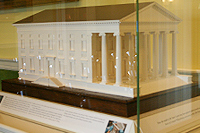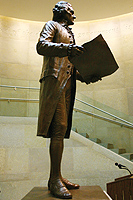George Washington Statue in the Rotunda

At the heart of the Capitol Rotunda stands a magnificent life-size marble statue of George Washington, commissioned by the General Assembly in 1784 as a tribute to Virginia’s most respected citizen-soldier. Governor Benjamin Harrison asked Thomas Jefferson, then serving in Paris, to help secure a sculptor.
Jefferson engaged the French artist Jean-Antoine Houdon, who traveled to Mount Vernon in 1785 to study Washington carefully. Houdon created a plaster mask of Washington’s face, took detailed body measurements, and modeled a terra cotta bust. From these studies, he sculpted the statue in fine Carrara marble and shipped it to America in 1796. The statue was placed in the Rotunda on May 14, 1796, where it has remained on nearly continuous display.
Contemporaries of Washington praised the work as a perfect likeness. The statue reflects the balance between Washington’s military and civilian life. He wears his Revolutionary uniform, but stands bareheaded with a fatherly expression. His sword rests at his side while his hand touches a Roman fasces, a symbol of authority. A plow and a walking cane beside him represent his return to the life of a farmer. This imagery recalls the Roman general Cincinnatus, who gave up power to return to private life.

Marquis de Lafayette Bust
The General Assembly also commissioned Houdon to create a marble bust of the Marquis de Lafayette, who was granted Virginia citizenship in 1785 for his service during the American Revolution. The bust was received from France in 1789.
Virginia’s “Hall of Presidents”
In 1930, the General Assembly authorized seven marble busts to be displayed in the Rotunda as a Virginia Hall of Presidents, privately funded and installed in 1931. Virginia, known as the “Mother of Presidents,” has had eight sons serve in the nation’s highest office. These busts honor Thomas Jefferson, James Madison, James Monroe, William Henry Harrison, John Tyler, Zachary Taylor, and Woodrow Wilson.
Fouquet Model of the Capitol
Displayed in the Jefferson Room is the original plaster model of the Capitol, created in France by Jean-Pierre Fouquet in 1785–86. Commissioned by Thomas Jefferson, the model reflects his vision of the Capitol as a “temple of sovereignty.” Jefferson hoped the design would impress foreign visitors, elevate America’s reputation, and inspire Virginians.

Mace of the Virginia House of Delegates
In the Old House Chamber, visitors can view the ceremonial mace of the House of Delegates. Today’s mace, crafted in England in the early 1900s, was presented to the House in 1974 by the Jamestown-Yorktown Foundation. Made of sterling silver with a 24-karat gold coating, it is 45 inches long, weighs ten pounds, and features oak leaves, acorns, and Virginia’s state flower, the dogwood.
The mace symbolizes authority and tradition. When the House is in session, the sergeant-at-arms carries it into the chamber and places it before the Speaker’s desk. When adjourned, it is returned to its glass display case in the Old House Chamber.
Virginia’s earliest maces date back to the colonial era, beginning with one gifted by the royal governor to the House of Burgesses in 1700. After independence, legislators felt that it was too strongly represented in links to the royalist past; legislators abandoned the colonial mace, and the House functioned without one for nearly 180 years.

Virginia’s second colonial mace was sold after the Revolution, as the legislators felt that it too strongly represented links to the royalist past. The House met without a mace for nearly 180 years. In 1974, the current mace was purchased in England by the Jamestown Yorktown Foundation and presented to the House of Delegates. Originally commissioned by a wealthy Englishman, the Edwardian-style mace was owned by several families before being purchased by an art dealer. After purchase by the foundation, the mace was stolen and then recovered by Scotland Yard just before it was to be melted down. The 45-inch-long mace is made of sterling silver and has a 24-karat gold coating that was electromagnetically applied in 1995. Reinforced with a wooden rod inside, the mace has four sections that feature likenesses of oak leaves, acorns, and blossoms resembling those of the dogwood, Virginia’s state flower.
Portrait Busts in the Old House Chamber
Along with the mace, the Old House Chamber contains portrait busts of notable figures in Virginia and American history:
- Meriwether Lewis – Co-leader of the Lewis and Clark Expedition and Governor of the Louisiana Territory.
- Cyrus Hall McCormick – Inventor of the grain reaper.
- Sam Houston – Virginia native and second President of the Republic of Texas.
- Richard Henry Lee – U.S. Senator from Virginia and 14th President of the Continental Congress.
- George Mason – Author of the Virginia Declaration of Rights and the Virginia Constitution of 1776.
- John Marshall – Fourth Chief Justice of the U.S. Supreme Court, U.S. Congressman, and Secretary of State.
- Patrick Henry – Famous for his “Give Me Liberty or Give Me Death!” speech, and the first Revolutionary Governor of Virginia.
- George Wythe – First Virginia signer of the Declaration of Independence and the nation’s first law professor.
- Andrew Lewis – Brigadier General who defeated Virginia’s last royal governor in battle.
Thomas Jefferson Statue in the Capitol Extension
In the Capitol Extension plaza, visitors are welcomed by a bronze statue of Thomas Jefferson, completed and dedicated in 2012. The privately funded statue shows Jefferson at age 42, holding one of his architectural drawings for the Capitol he designed.

